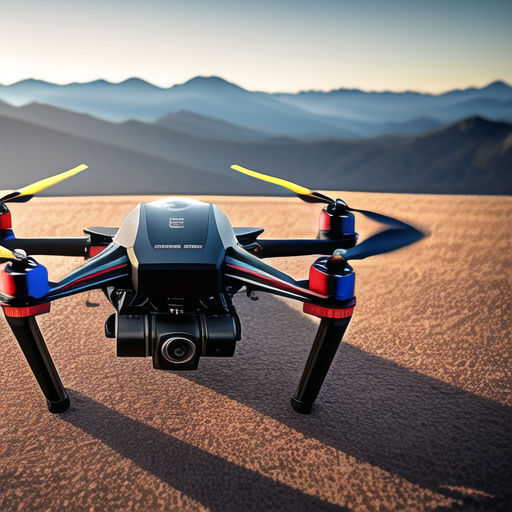The Truth About Drone Cameras with Thermal Imaging Technology

Unveiling the Power of Drones with Thermal Camera Technology
In the realm of aerial technology, drones with thermal cameras have emerged as game-changers, offering a unique perspective that traditional cameras cannot match. Understanding what sets thermal imaging apart and exploring the key features of top thermal drones can shed light on their unparalleled potential.
What Makes Thermal Imaging Stand Out
The Science Behind Thermal Imaging
Thermal imaging operates on the principle of detecting heat signatures emitted by objects, converting them into visible images. This technology relies on the fact that all objects emit infrared radiation based on their temperature, allowing thermal drones to capture this data and present it in a visual format.
Comparing Visual vs. Thermal Imaging
While visual imaging captures the appearance of an object or scene, drones with thermal cameras excel in detecting variations in temperature. This capability enables them to identify heat sources, even in low-light conditions or through obstructions such as smoke or foliage.
Key Features of Top Thermal Drones
Spotlight on DJI Matrice 30T and Autel Alpha
Leading the pack in thermal drone innovation are models like the DJI Matrice 30T and Autel Alpha. These cutting-edge drones with thermal camera technology offer high-resolution thermal imaging, precise temperature measurement, and advanced flight capabilities. Equipped with these features, they empower users across various industries to harness the full potential of thermal imaging for diverse applications.
Exploring the Multifaceted Applications of Drone with Thermal Camera
The integration of thermal imaging technology into drones has opened up a world of possibilities across diverse industries, revolutionizing traditional practices and enhancing operational efficiency. Let's delve into the multifaceted applications of drones with thermal cameras, showcasing their transformative impact.
Agriculture: A New Dawn with Thermal Imaging
In the realm of agriculture, the advent of drones with thermal cameras has ushered in a new era of precision farming. These advanced aerial platforms equipped with thermal imaging capabilities offer a bird's-eye view of vast agricultural landscapes, enabling farmers to monitor crop health and identify areas requiring attention.
Monitoring Crop Health from the Sky
Thermal drones play a pivotal role in monitoring crop health by detecting temperature differentials across fields. By capturing thermal data from above, these drones provide valuable insights into variations in plant health and hydration levels. This real-time information empowers farmers to make informed decisions regarding irrigation, pest control, and overall crop management, thereby optimizing yields and resource utilization.
Building Inspections Made Easy
The use of drones with thermal cameras has streamlined building inspections, offering an unparalleled level of precision and efficiency in identifying structural anomalies and weaknesses.
Identifying Structural Weaknesses with Precision
Equipped with high-resolution thermal imaging technology, these drones can detect temperature variations indicative of structural issues such as water infiltration, insulation deficiencies, or electrical irregularities. By conducting aerial thermographic surveys, inspectors can pinpoint potential problem areas without invasive measures, facilitating proactive maintenance and ensuring structural integrity.
Wildlife Conservation Efforts
In the realm of wildlife conservation, thermal drones have emerged as indispensable tools for safeguarding endangered species and preserving natural habitats.
Tracking and Protecting Endangered Species
By leveraging thermal imaging technology, conservationists can track elusive wildlife species that are otherwise challenging to monitor using conventional methods. The ability to detect heat signatures enables researchers to locate animals hidden within dense foliage or under the cover of darkness. Moreover, this technology aids in identifying poaching activities by detecting human presence in protected areas, bolstering conservation efforts and safeguarding biodiversity.
Utilizing innovative aerial solutions like drone with thermal camera technology is propelling various sectors toward enhanced productivity and sustainability through its diverse applications.
How Drones with Thermal Camera are Changing the Game in Emergency Situations
The integration of thermal imaging technology into drones has revolutionized emergency response capabilities, offering unprecedented advantages in critical situations. From search and rescue operations to firefighting and law enforcement, drones with thermal cameras have emerged as indispensable assets, reshaping the landscape of emergency interventions.
Search and Rescue Operations: A Beacon of Hope
In the realm of search and rescue missions, drones with thermal cameras serve as beacons of hope, enabling responders to locate missing individuals in unforgiving terrains with unparalleled efficiency.
Finding the Lost in Unforgiving Terrains
Equipped with advanced thermal imaging capabilities, these drones can detect heat signatures emitted by individuals, even in challenging environments such as dense forests or rugged mountainous regions. By capturing thermal data from above, emergency teams can swiftly identify and locate lost or injured persons, expediting rescue efforts and maximizing the chances of a successful outcome.
Firefighting: A New Perspective from Above
The utilization of drones with thermal cameras has ushered in a new era in firefighting strategies, providing firefighters with a comprehensive aerial perspective to combat blazes effectively.
Mapping Hotspots and Guiding Firefighting Efforts
By leveraging thermal imaging technology, these drones can swiftly identify hotspots within fire-affected areas, allowing firefighters to prioritize their efforts based on real-time data. The ability to map out the spread of fires and detect hidden sources of heat empowers firefighting teams to strategize their approach meticulously, leading to more efficient containment and suppression of wildfires. Additionally, these aerial platforms can guide water-dropping operations with precision, minimizing resource wastage while maximizing impact.
Law Enforcement: Enhancing Surveillance and Safety
In the domain of law enforcement, drones with thermal cameras have emerged as pivotal tools for enhancing surveillance capabilities and ensuring public safety through advanced aerial technology.
Tackling Crime with Advanced Aerial Technology
Equipped with high-resolution thermal imaging sensors, these drones bolster law enforcement efforts by providing an elevated vantage point for surveillance activities. They enable authorities to track suspects evading capture by detecting their body heat signatures from above. Moreover, during nighttime operations or in obscured locations, thermal drones offer a distinct advantage by overcoming visibility challenges that traditional surveillance methods encounter. This enhanced surveillance capacity contributes significantly to crime prevention and swift responses to unfolding incidents.
The seamless integration of drone with thermal camera technology into emergency response protocols is redefining the effectiveness and scope of operations across various sectors.
The Future of Drone with Thermal Camera Technology
As the technological landscape continues to evolve at a rapid pace, the future of drones with thermal cameras holds immense potential for groundbreaking advancements and expanded applications. From enhanced capabilities to novel fields of integration, the trajectory of thermal drone technology points toward a horizon brimming with innovation and opportunity.
Technological Advancements on the Horizon
What’s Next for Thermal Drones?
The evolution of drone with thermal camera technology is poised to witness significant strides in various aspects, encompassing both hardware and software enhancements. Foremost among these advancements is the refinement of thermal imaging sensors, paving the way for higher resolution and improved sensitivity to temperature differentials. This will enable thermal drones to capture more detailed thermal data, enhancing their capacity for precise analysis across diverse scenarios.
Moreover, advancements in flight control systems and autonomous navigation algorithms are set to elevate the operational efficiency and safety protocols of drones with thermal cameras. These developments will empower users with greater control over aerial maneuvers while ensuring seamless integration of thermal imaging data into their workflows.
Furthermore, the convergence of thermal imaging technology with artificial intelligence (AI) is anticipated to revolutionize the analytical capabilities of thermal drones. By leveraging AI algorithms for real-time data processing and pattern recognition, these drones can offer predictive insights into temperature trends and anomaly detection, thereby augmenting their utility across a spectrum of applications.
Expanding Horizons: New Fields of Application
Beyond the Expected: Uncovering New Uses
The proliferation of drone with thermal camera technology is not confined to its current domains but extends toward uncharted territories, unlocking innovative applications that transcend conventional boundaries.
One such emerging field is environmental monitoring, where drones with thermal cameras are poised to play a pivotal role in assessing ecological dynamics and climate patterns. By capturing thermal signatures indicative of environmental changes, these drones can contribute valuable data for scientific research and conservation efforts aimed at preserving delicate ecosystems.
Additionally, the realm of infrastructure maintenance stands to benefit significantly from the integration of thermal drones, as they offer a non-invasive means of inspecting critical assets such as bridges, pipelines, and power grids. The ability to identify temperature differentials associated with structural stress or material degradation equips engineers and maintenance personnel with early warning indicators, facilitating proactive interventions to ensure infrastructure resilience.
Furthermore, the fusion of drones with thermal cameras and public health initiatives presents an intriguing frontier wherein these aerial platforms can aid in disease surveillance by detecting variations in body temperatures within populations. This application holds promise for early detection and containment strategies during public health crises or epidemiological studies.
In essence, the future trajectory of drone with thermal camera technology encompasses not only technical advancements but also an expansive reach into novel realms that promise transformative impact across diverse sectors.
Final Thoughts
In conclusion, the potential of thermal drones transcends the boundaries of conventional aerial technology, offering a myriad of applications across diverse sectors. As innovators and enthusiasts continue to explore the capabilities of drones with thermal cameras, it becomes imperative to recognize and harness their transformative power.
Embracing the Potential of Thermal Drones
Embracing the potential of drone with thermal camera technology entails embracing a future where precision, efficiency, and innovation converge to redefine operational paradigms. The seamless integration of thermal imaging capabilities into aerial platforms has unlocked unprecedented avenues for addressing complex challenges and optimizing resource utilization.
From revolutionizing agricultural practices through real-time crop monitoring to enhancing emergency response protocols with advanced search and rescue capabilities, drones with thermal cameras have proven instrumental in elevating operational standards. Moreover, their role in wildlife conservation efforts and infrastructure inspections underscores their versatility and impact across ecological and industrial domains.
A Call to Action for Innovators and Enthusiasts
This is a call to action for innovators and enthusiasts alike to delve into the realm of thermal drones with unwavering curiosity and determination. By pushing the boundaries of technological innovation and exploring novel applications, they can propel this cutting-edge aerial technology toward new frontiers of possibility.
As we stand on the precipice of an era defined by technological prowess and ingenuity, it is incumbent upon us to seize the untapped potential of drones with thermal cameras. Through collaborative endeavors, research initiatives, and creative exploration, we can unravel new dimensions of utility for thermal drone technology that transcend existing paradigms.
In essence, embracing the potential of thermal drones is not merely an endeavor; it is an invitation to chart a course toward unparalleled innovation and impact across industries.
See Also
Uncovering the Influence of Thermal Imaging Cameras on Drone Tech
The Benefits of Employing Thermal Imaging Camera on Drone
Discovering the Creative Applications of Drone Thermal Cameras
Contact Us: Ms. Coco Huang
E-mail: sales@iasun.cn
WhatsApp/Wechat: +86 13510421923

